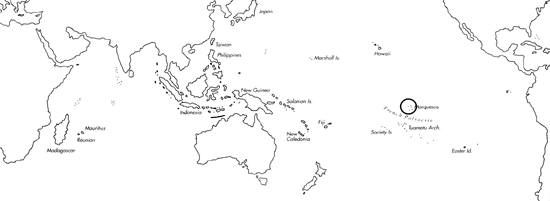Range: Marquesas.
Description: Moderately small to moderately large, moderately solid to solid. Last whorl conical, outline variably convex at adapical third and straight below. Shoulder carinate. Spire low, outline concave. Larval shell of about 2.0-2.25 whorls; maximum diameter 0.7-0.9 mm. First 4-6 postnuclear whorls distinctly tuberculate, later whorls sharply angulate to carinate. Teleoconch sutural ramps flat, variably concave in late whorls, with strong axial threads; 3 increasing to 5 wide spiral grooves and raised interstitial ribs on lateramps, containing spiral threads in latest whorls. Last whorl with variably spaced weak spiral grooves on basal third, separating ribs anteriorly and a few ribbons above.
| Shell Morphometry | ||
|---|---|---|
| L | 25-68 mm | |
| RW | 0.10-0.65 g/mm | |
| RD | 0.60-0.67 | |
| PMD | 0.88-0.90 | |
| RSH | 0.02-0.12 | |
Ground colour white. Last whorl with a rather regular network of reddish brown or sometimes yellow lines and triangular to rhomboid spots, edging larger sometimes confluent white tents and rhomboid flecks. Pattern may concentrate in 2 spiral band within adapical and abapical third. Apex white to violet., with white larval whorls. Later sutural ramps with reddish brown or yellow radial lines and streaks. Aperture white, sometimes suffused with pale violet.
Periostracum greyish yellow, very thin and translucent, smooth.
Habitat and Habits: In 12 - 40 m on sand.
Discussion: C. marchionatus is very close to C. cordigera; both have been synonymized with C. nobilis. Typical shells of C. cordigera have narrower last whorls (RD 0.50-0.58), while shells of form bitleri have similarly broad but more ventricose last whorls (PMD 0.83-0.90). The shoulder is not carinate but angulate in C. cordigera, and its colour pattern yellowish brown to brown instead of primarly redish brown. These differences as well as the widely disjunct ranges suggest a separation on the species level. A 2 million years old fossil from Fiji, highly similar to C. cordigera, supports the close relationship (Kohn,unpubl. observ.). C. nobilis differs from C. marchionatus in its narrower last whorl (RD 0.47-0.57), its non-tuberculate early postnuclear whorls, and its dark coloured base. It can be additionally distinguished by the very fine darker axial lines and the coarse alternating brown and white spiral lines within the colour zones of its last whorl.

C. marchionatus range map
This section contains verbatim reproductions of the accounts of 316 species of Conus from the Indo-Pacific region, from Manual of the Living Conidae, by Röckel, Korn and Kohn (1995). They are reproduced with the kind permission of the present publisher, Conchbooks.
All plates and figures referred to in the text are also in Röckel, Korn & Kohn, 1995. Manual of the Living Conidae Vol. 1: Indo-Pacific Region.
The range maps have been modified so that each species account has it own map, rather than one map that showed the ranges of several species in the original work. This was necessary because each species account is on a separate page on the website and not confined to the order of accounts in the book.